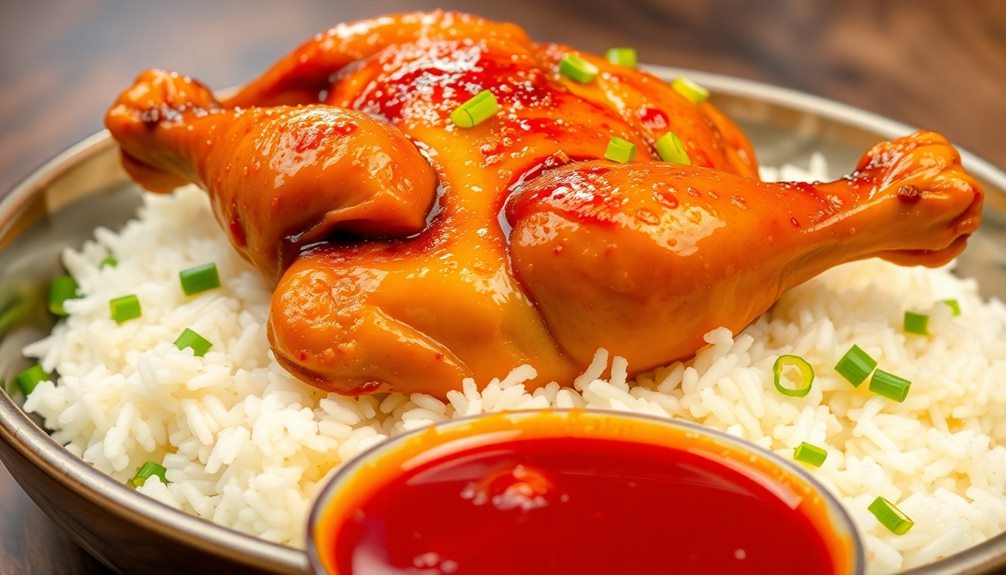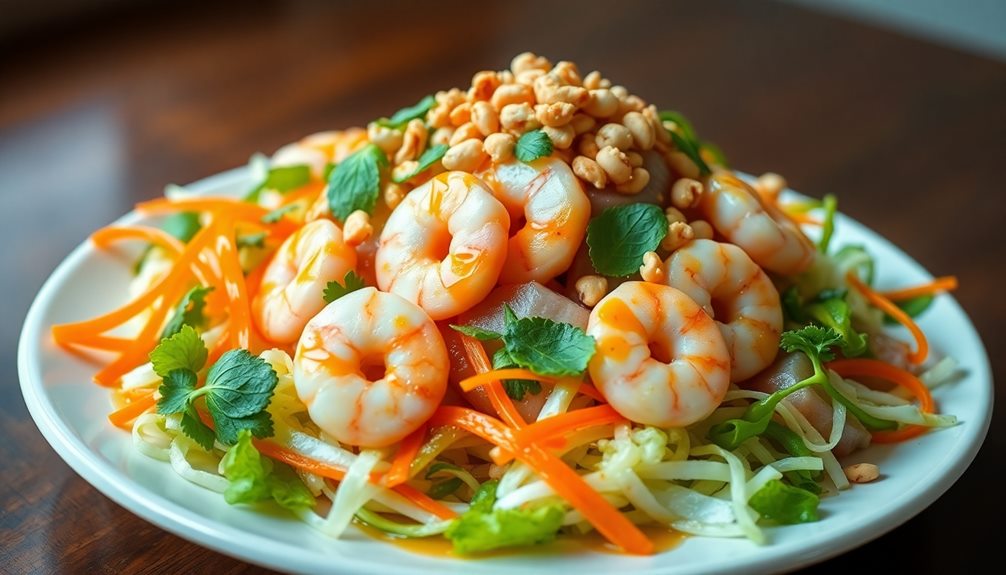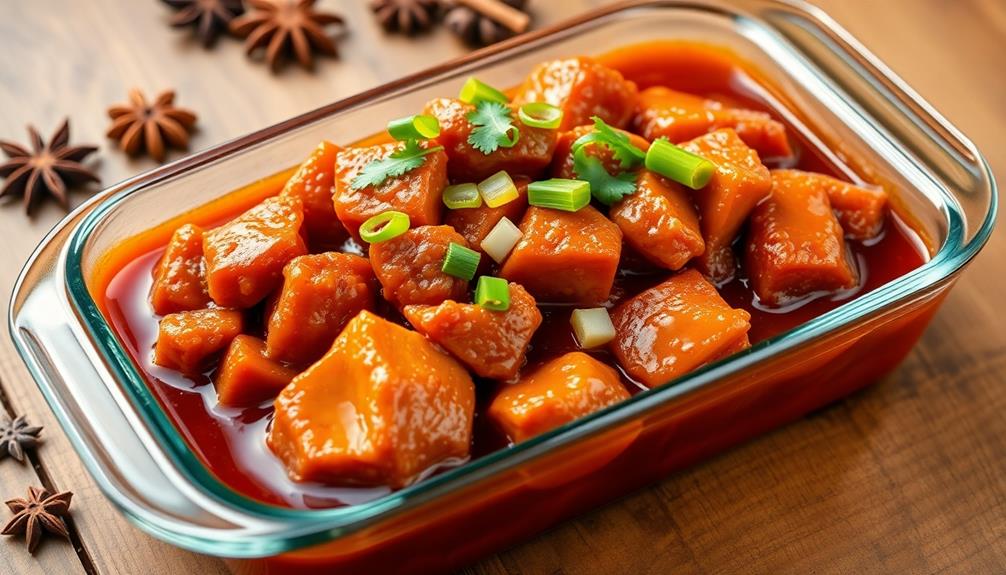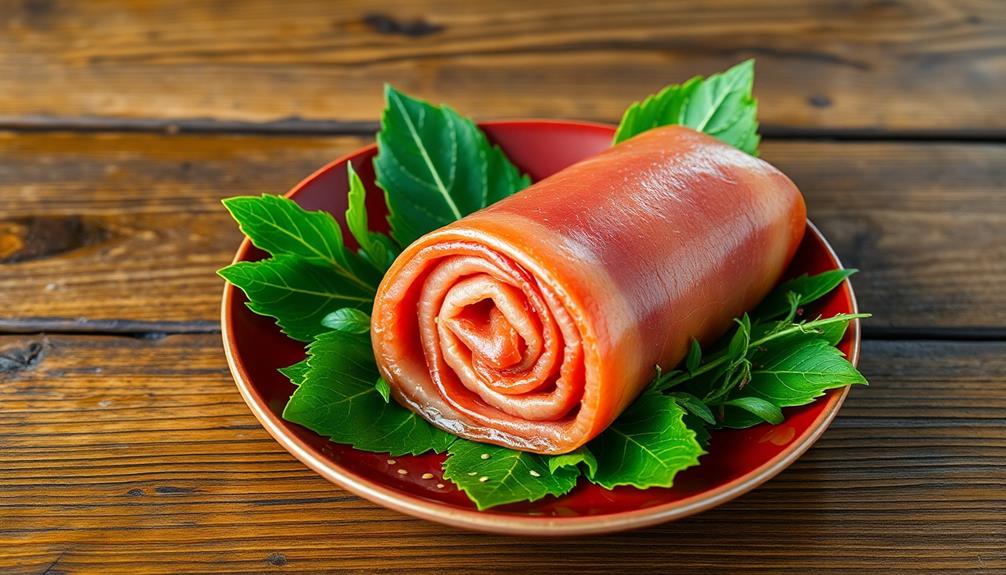Hainanese chicken rice, a beloved dish from China's Hainan province, has found a scrumptious home in Vietnam. You'll start by rinsing and cleaning the chicken to remove any impurities, then cutting it into perfect serving pieces. Next, you'll bring the chicken to a boil, simmering it until it's juicy and tender. Don't forget to skim the broth, removing any foam or unwanted bits for a clear, rich liquid. Serve the chicken over fragrant, oily rice cooked in the same broth for an authentic taste. This Vietnamese twist on a classic dish is sure to delight your taste buds – and there's more to discover about this beloved comfort food.
Key Takeaways
- Incorporate Vietnamese flavors and ingredients into the traditional Hainanese chicken rice recipe for a unique and flavorful twist.
- Utilize Vietnamese spices like lemongrass, fish sauce, and nuoc cham to enhance the overall taste profile of the dish.
- Explore alternative rice cooking methods, such as using a rice cooker or steaming the rice, to achieve the desired texture and aroma.
- Experiment with different garnishes and accompaniments, like pickled vegetables or fresh herbs, to complement the chicken and rice.
- Highlight the cultural fusion by presenting the dish in a visually appealing manner, blending Hainanese and Vietnamese culinary aesthetics.
History

Hainanese chicken rice traces its origins back to the Hainan province of China, where it was a staple dish among the local Hainanese people.
These folks had a knack for cooking chicken to perfection, poaching it in a flavorful broth that kept the meat juicy and tender. The cooked chicken was then paired with fragrant, oily rice that had been prepared using the same broth.
This humble yet delicious dish quickly became a beloved part of Hainan's culinary heritage.
Over time, as the Hainanese people migrated to other parts of Southeast Asia, they brought their signature chicken rice with them. In Singapore and Malaysia, the dish evolved, with local ingredients and cooking techniques being incorporated to create the mouthwatering versions we know and love today.
From its humble beginnings in Hainan, Hainanese chicken rice has become a beloved global phenomenon, delighting food lovers around the world with its unique blend of flavors and textures.
Cooking Steps
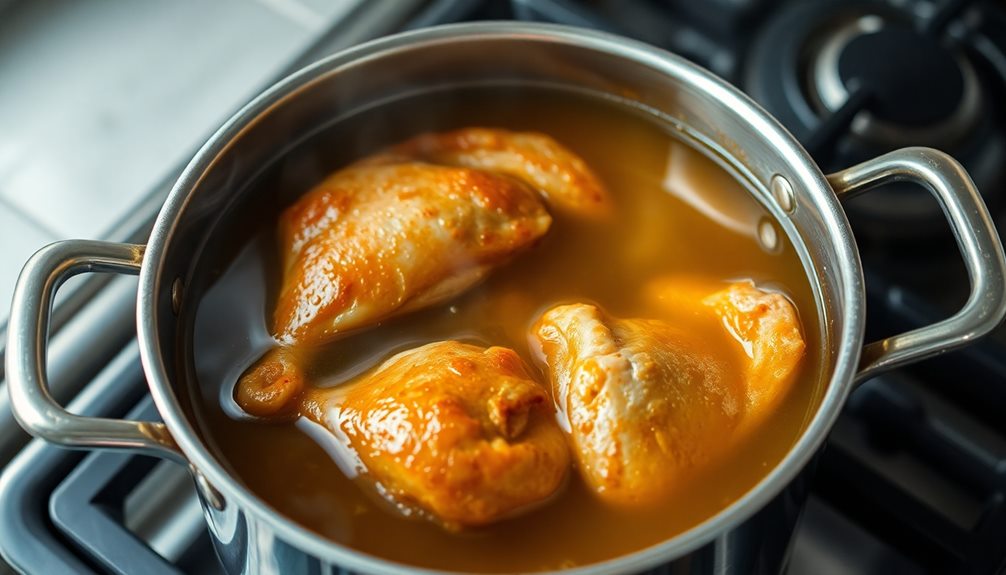
To prepare the perfect Hainanese chicken rice, begin by thoroughly rinsing the chicken. Pat it dry, then rub the bird all over with salt.
Place the chicken in a large pot and cover it with water. Bring the pot to a boil, then reduce the heat and simmer for 1 to 1 1/2 hours, until the chicken is cooked through.
Once the chicken is done, remove it from the pot and let it cool slightly. Shred the meat into bite-sized pieces. Strain the cooking liquid and reserve it for the rice.
In a clean pot, toast the rice over medium heat until it's lightly golden. Add the reserved cooking liquid and a bit of salt.
Bring it to a boil, then cover, reduce the heat to low, and simmer for 15-20 minutes, until the rice is tender and fluffy.
Serve the chicken over the fragrant, oily rice, garnished with sliced cucumber, coriander, and a drizzle of the savory cooking liquid. Enjoy this comforting, flavorful dish!
Step 1. Rinse and Clean the Chicken
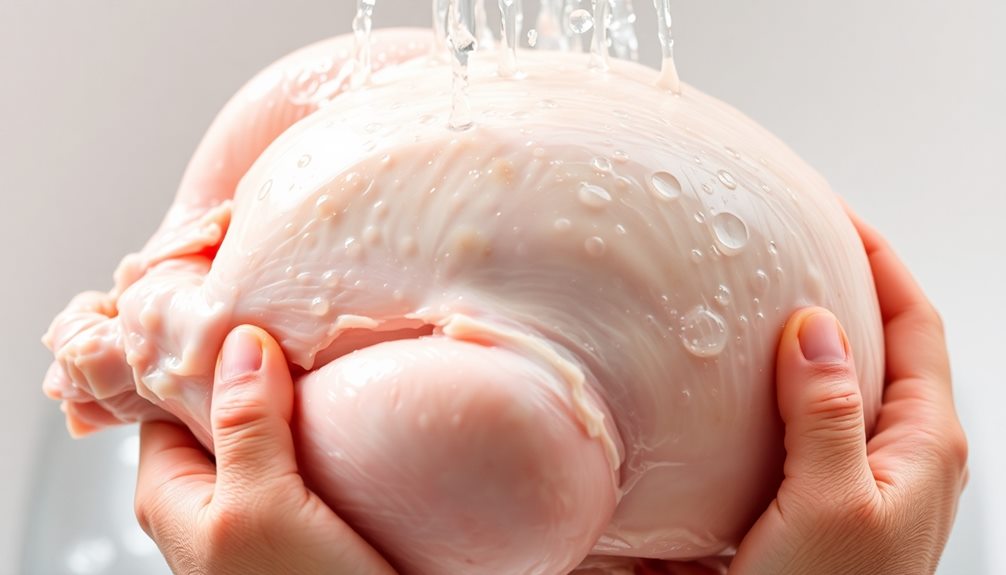
The first step in preparing the perfect Hainanese Chicken Rice is to thoroughly rinse and clean the chicken.
You'll want to start by removing the chicken from its packaging and placing it under cool, running water. Gently rub the skin with your fingers to loosen any dirt or impurities.
Be sure to pay close attention to the nooks and crannies, like the cavity and under the wings, to ensure the whole bird is clean.
Once the chicken looks sparkling, pat it dry with some paper towels.
This step may seem simple, but it's crucial for getting the best flavor and texture in your final dish.
By removing any residual bacteria or impurities, you're setting the stage for a moist, flavorful chicken that will be the star of your Hainanese Chicken Rice.
With the chicken prepped, you're now ready to move on to the next step in this delicious cooking process.
Step 2. Prepare Chicken by Cutting

Next, grab a sharp chef's knife and carefully cut the chicken into desired serving pieces.
Start by separating the chicken legs and thighs from the body. Gently slice along the joints to detach them.
Then, cut the chicken breasts in half, creating four equal-sized portions. For the wings, simply snip them off the body at the joint.
Lastly, use the knife to slice the chicken breast pieces in half horizontally, creating thin, tender fillets. This will ensure the chicken cooks evenly and absorbs all the delicious flavors of the dish.
Be mindful of your fingers as you work, keeping them clear of the blade. Take your time and use smooth, controlled motions to get clean, uniform cuts.
With the chicken prepped, you're well on your way to an authentic Hainanese chicken rice experience!
Step 3. Bring Chicken to a Boil
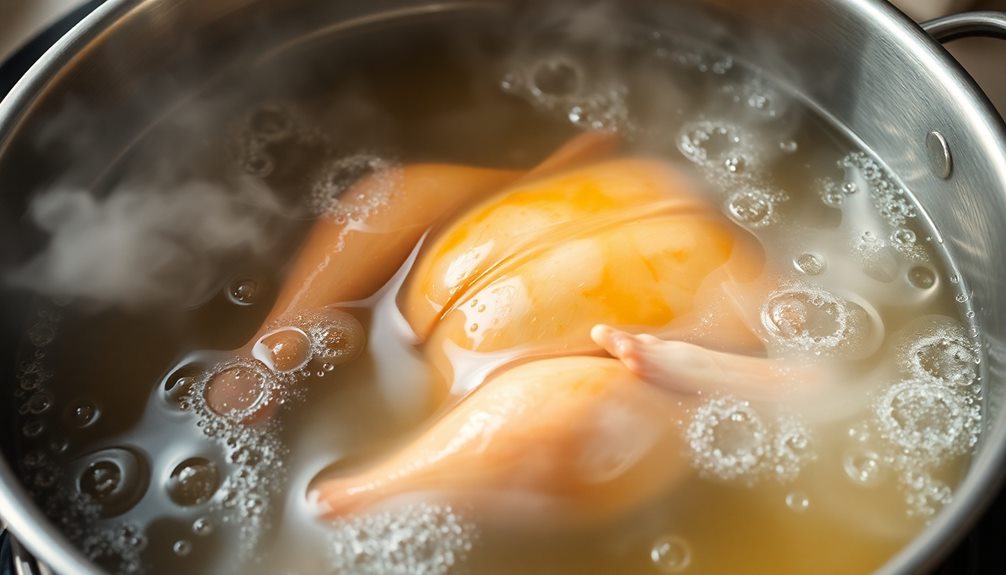
With the chicken prepped, it's time to get cooking. Bring a large pot of water to a boil over high heat. Carefully lower the whole chicken into the boiling water. The water should cover the chicken completely.
Let the chicken simmer for about 30 minutes, or until the juices run clear when you pierce the thickest part of the thigh with a fork.
Use a pair of tongs to gently remove the chicken from the pot. Transfer it to a cutting board and let it rest for 10 minutes. This allows the juices to redistribute throughout the meat, ensuring your chicken stays moist and flavorful.
While the chicken rests, keep the pot of chicken broth simmering on the stove. You'll use this flavorful broth later to serve with the rice.
Now, it's time to carve the chicken. Slice it into bite-sized pieces, keeping the skin intact. The chicken is now ready to be served with the fragrant Hainanese rice.
Step 4. Simmer Chicken Until Tender
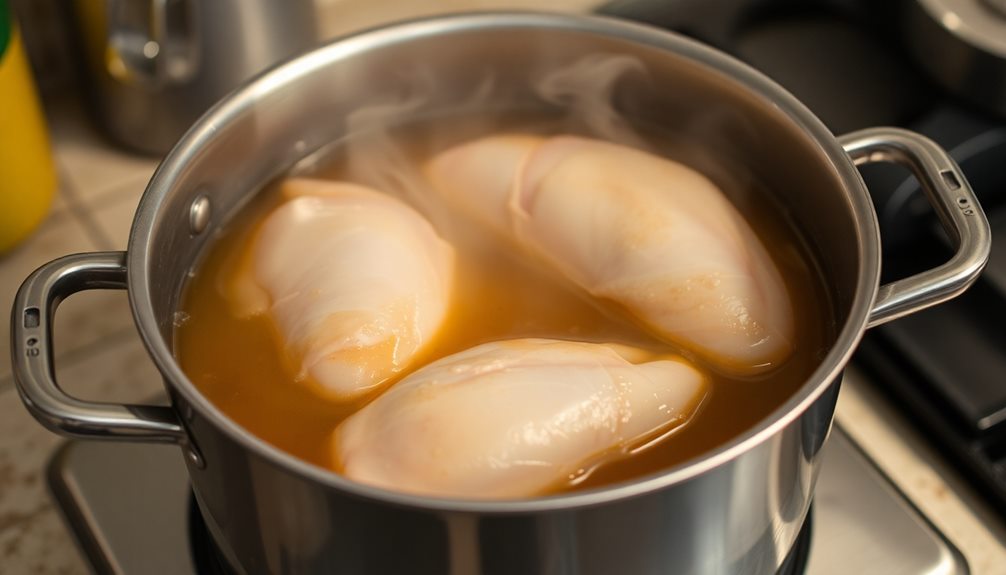
How do you ensure the chicken simmers until it's tender? First, you'll want to gently lower the chicken into the simmering broth. Make sure the liquid covers the chicken completely.
Then, set the heat to medium-low and let the chicken simmer for about 30 minutes. As it cooks, the meat will become increasingly tender and juicy.
To test for doneness, use a pair of tongs to lightly squeeze the thickest part of the chicken. If it feels firm but still has a bit of give, it's ready. You can also insert a thermometer – the internal temperature should reach 165°F.
Be careful not to overcook, as that can make the chicken dry and tough.
Once the chicken is cooked through, use the tongs to carefully transfer it to a cutting board. Let it rest for 5-10 minutes before slicing into it.
This allows the juices to redistribute, ensuring every bite is moist and flavorful. With a little patience, you'll have perfectly tender Hainanese chicken, ready to serve over fragrant rice.
Step 5. Skim and Discard Chicken Broth
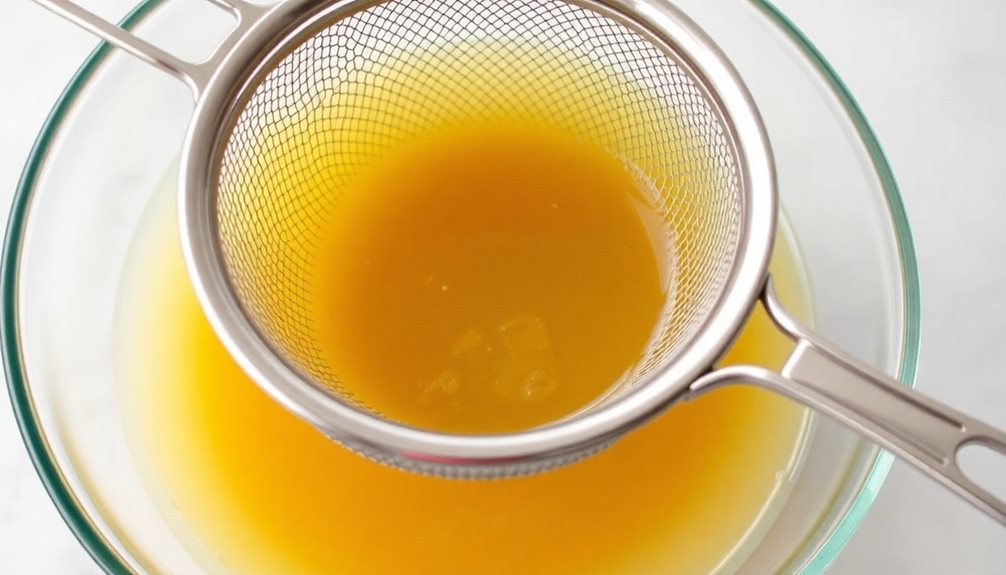
After the chicken has simmered to tenderness, skim any impurities or foam that have risen to the surface of the broth. This step is crucial to ensure your broth is crystal clear and free of any undesirable bits.
Carefully use a ladle or spoon to gently scoop away the layer of foam or scum that has accumulated. Don't worry, this is completely normal and happens when you're cooking meat.
Once you've removed all the impurities, discard them. You don't want those floating around in your final dish. This step may take a few minutes, but it's worth it to get a clean, flavorful broth.
With the broth now skimmed and purified, you're well on your way to creating an authentic Hainanese Chicken Rice dish. The clear, aromatic broth will be the foundation for the rice and provide the perfect accompaniment to the tender, juicy chicken.
Final Thoughts

Ultimately, Hainanese chicken rice remains a beloved and iconic dish that has stood the test of time. Its combination of juicy, flavorful chicken and aromatic, oily rice has captivated the hearts and taste buds of countless people around the world.
Whether you enjoy it in the bustling streets of Singapore or a cozy Vietnamese kitchen, this dish never fails to bring a smile to your face and a sense of comfort to your soul.
As you've discovered, the key to perfecting Hainanese chicken rice lies in the meticulous attention to detail, from the careful poaching of the chicken to the precise seasoning of the rice.
By incorporating the Vietnamese twist, you've added your own unique flair to this classic, creating a dish that's both familiar and refreshingly different.
The skim and discard method for the broth has ensured a clear, rich liquid that enhances the overall experience.
Frequently Asked Questions
How Did Hainanese Chicken Rice Become Popular in Vietnam?
You know, Hainanese chicken rice became popular in Vietnam because Vietnamese immigrants brought the dish with them when they settled in the country. Over time, they adapted it to local tastes, creating a unique Vietnamese variation.
What Distinguishes the Vietnamese Version From the Singaporean Version?
The Vietnamese version of Hainanese chicken rice differs from the Singaporean version in its use of more herbs, pungent fish sauce, and a spicier dip. It has a distinct Southeast Asian flair that sets it apart.
Can the Dish Be Made With Other Types of Protein?
You can absolutely make the dish with other proteins like pork, beef, or shrimp. The key is to cook the protein using the same flavorful rice cooking method to infuse it with the signature taste.
What Are Some Common Side Dishes Served With This Dish?
Common side dishes served with this dish include cucumber salad, pickled vegetables, and steamed or stir-fried greens. You can also serve it with a variety of sauces and condiments to enhance the flavors.
How Can the Dish Be Made More Healthier?
To make the dish healthier, you can use lean chicken breasts, brown rice instead of white, and add more vegetables like carrots, broccoli, or spinach. You can also use low-sodium soy sauce and limit the oil used in cooking.
